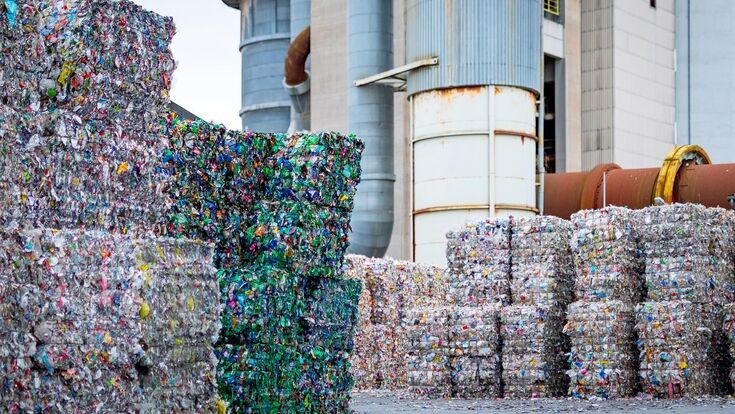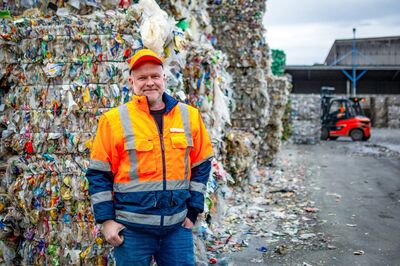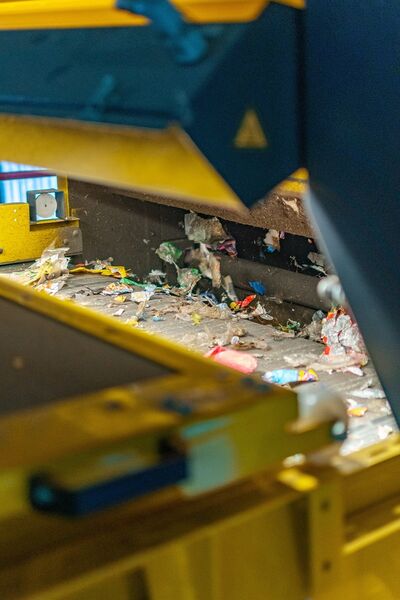Plastic Recycling : Former coal storage transformed into sustainable plastic processing facility

What was previously a cement production and coal storage site is now used to sort plastics for recycling.
- © STEINERTIn 2014, Umweltdienste Kedenburg took over a sorting plant for packaging waste on the site of a former cement works in Beckum. Ten years later, Beckum Kunststoff Recycling GmbH, a joint venture with Otto Graf GmbH, built a second plant on the site where coal for cement production used to be stored. Today, the site produces sustainable recycled plastic and is a great example of how the circular economy is transforming historic industrial sites. Klaus Kuhlenbeck, Technical Director of the facility, describes the project as an investment in the circular economy: “Our goal is clear: to sort and process plastic films to such a high level that we can create new products out of them.”
Turning waste into a quality product
The result is a state-of-the-art sorting facility for processing plastics from mixed post-consumer packaging. Around two-thirds of the input is polypropylene (PP) film, with the remainder consisting of polyethylene (PE) and a mixture of polyolefins (PO), mainly from pre-sorted material from post-consumer packaging plants across Europe - from Austria to Norway.
Precision technology provides the key to success
At the heart of the facility are two STEINERT UniSort Film EVO 5.0 machines, which use a special airflow system, synchronised precisely to the belt speed. “We were particularly impressed with the directional and stabilised airflow”, explains Kuhlenbeck. “This means that even lightweight and flexible films remain firmly on the conveyor belt. And the airflow works right into the discharge hood so that the material hardly swirls at all after shooting out. The UniSort Film is the most fully developed solution currently available on the market for our requirements.”
This precise flow of material permits a belt speed of 4.5 m/s, which is essential to high throughput and cost-effective sorting, especially with awkward 2D materials. With plastic films in particular, they are thereby prevented from overlapping or twisting and only then can the combination of sensors from the near-infrared sensor (NIR) and colour camera be fully effective. This accurate form of data capture is required to reliably achieve the desired purity rate of 98 percent from PP film.

Flexible enough to rise to future challenges
Correctly sorted plastic film becomes a secondary raw material through further processing steps, including agglomeration of the film and shredding of the hard plastics into flakes. These intermediate products are then passed through the STEINERT MOH magnetic combination separator with EddyC FINES to remove tiny ferrous and non-ferrous particles. The plastic agglomerate then goes directly to GRAF, where it is used to make durable products for rainwater harvesting. Customers benefit from products that are not only sustainable, but also have the same quality as new products, without having to make any compromises.
Klaus Kuhlenbeck stresses how important it was to him that his investment was future-proofed: “We have consciously designed our facility such that we can flexibly respond to changing requirements. We are aware that packaging materials are changing all the time. With the NIR and colour sensor combination, we can adapt to future trends.”
Kuhlenbeck clearly believes that: “A facility is never really ever complete. We are continually coming up against new challenges, such as composite materials, that are still hard to sort, or aluminised films, which can impact on the end product if not detected and removed.” And this is exactly why he stresses the importance of dialogue along the value-added chain: “For decades, companies worked alone. Only now are we really starting to talk to one another. So together we are improving recycling, creating better packaging and driving the circular economy forwards.”

Building confidence through tests
The collaboration with STEINERT started in the company’s own Test Center at its headquarters near Cologne, where the course for this successful project was set back in 2023. “Right from the start, the STEINERT machines have done exactly what they promised to. I’ve rarely experienced anything like it. This is the kind of reliability we need for our vision of sustainable plastic recycling,” says Kuhlenbeck by way of summary. Thanks to the new facility in Beckum, the site of a former emitter of CO₂ is becoming a pioneer in sustainability. With every kilogram of plastic that is returned into the cycle, Beckum Kunststoffrecycling GmbH is actively helping to protect the climate, save CO₂ and preserve natural resources.

